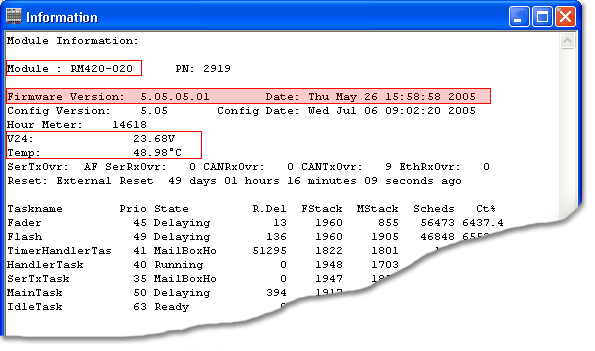In the Memory Map, the Firmware follows the Boot Loader. This is the actual “Operating System” of the microcontroller, a complex piece of software that is stored in the “Firmware” area of the flash memory.

The firmware is loaded after startup of the Boot Loader and after a valid firmware version is recognized in the memory of the microcontroller. This restart happens always after power-cycling the module or after a software reset. (see also Memory Access at System Reset)
After startup, the firmware checks on which kind of module it is running. This way, it can determine which functions can be executed on this module. It also depends on the configuration, which of the available functions are actually executed on the module. In theory, all modules of the same version use the same firmware. According to the kind of module and the configurations used, the functions acutally used can vary.
![[Note]](../pics/note.gif)
|
Note |
|---|---|
|
If a module has a valid firmware version and if this way successfully loaded by the microcontroller, you can see that in the Maintenance window of the Toolbox4software: The corresponding module is displayed with its correct type name in the module tree of the Device. |
|

The memory area “Firmware” can be accessed by the RM4200D user, i.e. it can be overwritten. This is necessary if you want to modify the firmware already loaded in the system. This mostly happens if you want to carry out a firmware update
The firmware contains information on all available modules and their functions. This is possible since the same type of microcontroller is used on all modules.
To do this, use the Maintenance window of the Toolbox4-Software. In the menu, use the command to select a firmware file and transfer it to the RM4200D.
![[Important]](../pics/important.gif)
|
Important |
|---|---|
|
You must start a firmware update always manually. There is no function for automatic firmware updates! |
|
A firmware update becomes necessary, if you want to use a function of the RM4200D that is not yet supported by the firmware currently running in the device. Also, firmware updates correct known software bugs of older versions.
DHD regularly publishes new firmware versions that contain bug fixes or new functions. The firmware is stored in a special file which you can transfer to the modules of RM4200D using the Toolbox4 software. The firmware file can be recognized as follows:
-
File name: From the filename, you can always tell the version on the contained firmware. Thus, the firmware file belonging to the module information shown above would be called RM4200V05-05-05.upd, since the version is 05.05.05. ???
-
File extension: A firmware file for a RM4200D has always the extension *.udp.
![[Important]](../pics/important.gif)
|
Important |
|---|---|
|
You can obtain notes on modifications and functions of certain firmware versions as well as the current state of development from your DHD dealer or directly from DHD. From there, you can also be provided with firmware updates as files. |
|
![[Important]](../pics/important.gif)
|
Important |
|---|---|
|
Make sure that all Modules of a RM4200D are running with the same firmware version. If not, the system can react unpredictably. Different firmware versions in one system can occur, if modules are replaced, which carry a microcontroller with a different firmware version. |
|
If DHD delivers one or more RM4200D, all modules of this delivery contain the same firmware version. For setting into operation, the most current version or the one recommended by DHD is installed (Recommended Version). You find the corresponding firmware file also on the CD enclosed with the RM4200D.
![[Tip]](../pics/tip.gif)
|
Tip |
|---|---|
|
Occasionally, you might use RM4200D modules with initially different firmware versions together. In this case, you always have to install a new firmware file to bring all modules up to the same position. It has proven successful to trigger a reset of the Device from the Maintenance window prior to installing the new firmware. To do this, use the command from the contextual menu of the Device or the appropriate command from the menu. |
|